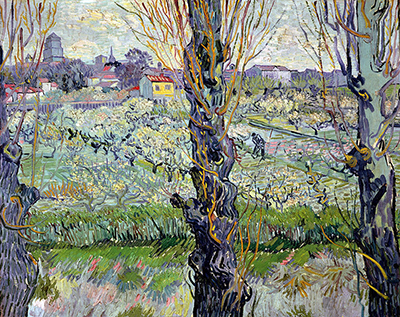View of Arles Flowering Orchards, a large oil on canvas, was begun by Vincent van Gogh in the spring of 1889. The orchards of Arles had made a great impression on him upon his arrival there the previous year.
The beautiful sight of apple, almond and apricot blossom instantly inspired many fine works. This particular canvas depicts a middle ground filled with rows of pale green, purple-tinged plum trees in full bloom. They are being tended by a solitary, stooping figure which is an almost obligatory feature of many of van Gogh's paintings such as the Farmhouse in Provence. However, View of Arles is unusual as it contradicts van Gogh's frantic style of painting which enabled him to complete works in one session.
View of Arles Flowering Orchards had been started shortly after van Gogh's furious arguments with Paul Gauguin exacerbated a severe mental collapse. The painting accompanied van Gogh on his voluntary incarceration at Saint-Rémy in May 1889. In letters to his brother, Theo, he described how he continued to work from memory to gradually improve the harmony of the painting's tones and refers to experimenting with effects such as stippling. The painting is dominated by three gaunt, gnarled poplar trunks, one in the centre and one on each edge of the canvas. The abrupt cropping of the trees is reminiscent of his admiration for traditional Japanese art which uses a similar technique. The trees are also symbolic of the barred window van Gogh peered out of from his cell in the asylum. They certainly help to convey an appreciation of the isolation van Gogh must have experienced. The sense of remoteness is increased by the out of reach town in the distance on the far side of the orchards.
The bold, well-defined brushwork of the poplar trees becomes more muted in the town of Arles with its towers of Notre-Dame-le-Major and Saint-Trophime. The sombre purple tone of the painting connects the poplars to the distant buildings of Arles to from a frame or barrier around the central pale green orchard adding to a sense of desolation in the view itself. In the previous year of 1888, Paul Gauguin had painted Landscape at Pont-Aven which depicts a distant view glimpsed through a line of birch trees. A similar scene is contained in his Large Tree of 1889. As an enthusiastic admirer of his work, it's possible that van Gogh was inspired by Gaugin's ideas during their brief collaboration. View of Arles Flowering Orchards was eventually exhibited in Brussels in 1890. Today, Van Gogh's poplars continue to grow beside the canal but some of the town's landmarks no longer exist. View of Arles Flowering Orchards can be viewed at Neue Pinakothek Museum in Munich.




